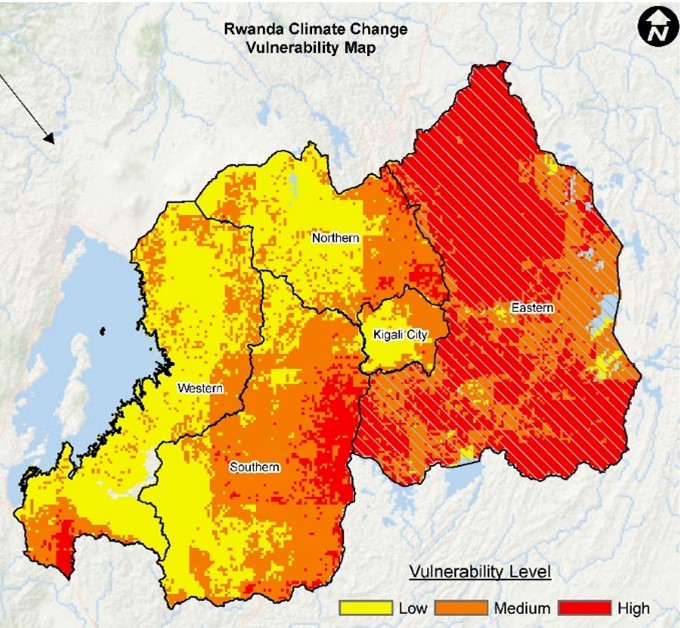| A B S T R A C T | |
| The transition to agroforestry through enhancing ecosystem services is pivotal in achieving Sustainable Development Goals (SDGs) in developing countries, including Rwanda. This study examines the centrality of ecosystem services in influencing widescale agroforestry adoption for its socioeconomic and environmental benefits. Data was collected from 920 households using stratified random sampling, with logistic regression models employed to analyze factors affecting adoption. Results indicate that ecosystem services such as soil erosion control, microclimate regulation, and carbon sequestration significantly motivate agroforestry adoption. Socioeconomic factors, including education and income levels and institutional settings like access to credit and extension services, further influence adoption rates. Moreover, farmers planned behaviours, shaped by perceived behavioral control and subjective norms, critically mediate adoption decisions. The findings underscore that integrating ecosystem services into agricultural and environmental policies is a cost-effective pathway to align local farming with global sustainability targets such as the United Nations Framework Convention on Climate Change. Policy recommendations include targeted awareness programs, improved institutional frameworks for farmers’ education and credit access, and economic incentives to amplify the agroforestry transition in rural Rwanda. | |
- Introduction
The world faces a triple crisis of climate change, biodiversity loss, and land degradation that threaten people’s livelihoods, as well as the attainment of the Sustainable Development Goals (SDGs). Agroforestry, a land management practice that integrates trees and shrubs alongside crops or livestock [1], is an effective strategy for enhancing ecosystem services while promoting sustainable agriculture. The Sixth Assessment Report of the International Panel on Climate Change (IPCC) highlighted that agroforestry can improve resilience to climate impacts and advance mitigation through carbon sequestration in trees and soils [2]. Since Rwanda’s Eastern Province is characterized by land degradation and food insecurity, agroforestry offers a transformative pathway towards achieving SDGs such as Zero Hunger (SDG 2), Climate Action (SDG 13), and Life on Land (SDG 15). Despite this vast potential and the country’s goal to 100% agroforestry transition by 2030, widespread adoption efforts remain ineffective partly due to the paucity of evidence of effective pathways that consider adopters’ perspectives on the ecosystem services ̶ public goods produced by agroforestry systems. This study focuses on understanding the drivers of agroforestry adoption and its implications for ecosystem services, farmer behavior, and SDG outcomes. The Eastern Province of Rwanda was selected because of its country’s food basket status, potential for agricultural development, and high degradation level, which is coupled with its being the most populated province. The study’s rationale is that when comprehensively considered in the design of agroforestry development interventions, the agroecological, societal, market, and policy enablers will critically drive adoption and produce multiple benefits to specific agroecological zones of Rwanda. The study aims to promote agroforestry and the ecosystem services it generates to fast-track the achievement of sustainable development goals in rural Rwanda.
While other adoption studies prioritized evaluating the contribution of socioeconomic and institutional settings of agroforestry systems in the adoption process, this study focuses on exploring four categories of adoption factors: socioeconomic, ecosystem services, institutional setup, and psychosocial, separately and combined. This combination, along with the coverage of all seven districts of the eastern province, makes this study the first of its kind in Rwanda, using integrated conceptual frameworks in the adoption study, as explained in section three. This study hypothesizes that these four categories of adoption factors, considered explanatory variables in the analytical framework, impact the AF adoption in the study area, and are considered the dependent variable. This study attempts to draw the attention of policymakers, practitioners, and researchers to agroforestry ecosystem services’ high potential in influencing adoption and later positively affecting people and nature resilience. It attempts to answer the research question, “To what extent did the production of ecosystem services influence farmers to adopt agroforestry systems (AFS)?” The rest of the paper is structured around the presentation of the literature review (section 2), the conceptual framework (section 3), and the methodology (section 4). While section 5 presents and discusses results, their conclusion and related recommendations are presented in section 6.
2. Literature Review
2.1. Agroforestry System
Rooted in the concepts of agrisilviculture and agrosilviculture, various authors have defined agroforestry in terms of its features, arrangement, and ultimate goals. For example, Leakey R.R.B defines it as “a deliberate introduction or retention of trees on farms through either spatial or temporal arrangements to increase, diversify, and sustain production for increased social, environmental, and economic benefits”[3]. This, and many other definitions, allude to the fact that agroforestry is not merely a mixture of trees, crops, and animals in the same farmland but a well-thought-out land use system to optimize land and achieve many benefits. Although multi-state systems like home gardens, silvopastoral systems, live fences, and windbreaks, as well as annual and perennial crops grown in shadow, are the most popular types of agroforestry systems[4], their precise characteristics differ greatly depending on the goals, species, and system design [5]. As shown in Table 1, agroforestry practices are applied to each of the four systems (Agro-silviculture, silvopastoral, agro-silvopastoral). According to Atangana et al., agroforestry system classification could be defined by vegetation structure, input mix, spatial and temporal arrangement, function, and purpose.
Table 1: Classification of AF systems
| System/Practice |
| Agro-silviculture: |
| Multipurpose trees |
| Hedgerows, shelterbelts, and windbreaks systems |
| Alley cropping |
| Improved or rotational fallow |
| Riparian buffer strips |
| Silvopastoral: |
| Trees/Shrubs on pasture |
| Meadow orchards |
| Hedgerows, shelterbelts, and windbreaks systems |
| Agro-silvopastoral: |
| Integration of animal husbandry (dairy, meat), crop, and wood/fuelwood. |
2.2. Factors affecting Adoption of Agroforestry System
Drivers for agroforestry adoption by farmers differ in biophysical conditions and socioeconomic characteristics, which are both balanced by environmental restoration concerns. According to Willemen et al., farmers decide to plant trees on farms as a livelihood strategy aiming at producing multiple ecosystem services in consideration of agroecological and economic conditions and their subjective preferences [6]. From the economic theory perspective, farmers are likely to adopt agroforestry systems when their financial returns are higher than other land use alternatives [7]. Of course, financial return and economic viability depend on different factors, too. For example, one study in Tanzania suggested that a set of household and socioeconomic factors drove the uptake of agroforestry [8]. At the same time, another in South Africa in South Africa revealed that agricultural farming experience, household head’s education level, and land size are critical determinants of agroforestry adoption [9]. These factors interact to assist farmers in valuing the financial returns of agroforestry before adoption while allowing farmers to apply agroforestry management practices appropriately. However, financial returns are not always straightforwardly gained because they require other enabling conditions such as institutions, policy, and economic incentives that could favour agroforestry adoption [10].
The evaluation of the extent of agroforestry adoption by smallholder farmers in Rwanda revealed that agroforestry drivers vary across agroecological zones. For example, farmers in the highland systems took advantage of varied topographies, less fertile soils, and steep slopes to adopt AF, while flat landscapes and extensive Savanna and Plateau farming systems failed to incentivize agroforestry adoption [10]. At the same time, fodder adoption was minimal in Eastern Savanna, where open grazing is still practiced [11]. Furthermore, Bucagu identified biophysical (rainfall, field type), socioeconomic conditions (wealth status, household head education), and farmer preference as adoption factors in Rwanda [12].
2.3. Agroforestry-based Ecosystem Services
The term ecosystem services (ESs) has gained prominence in contemporary scientific research and policy agenda due to its relative importance to individuals, communities, and economies and its environmental benefits. Herman Daly and Joshua Farley define ecosystem services as all benefits humans can derive from natural ecosystems for their physical, social, and economic well-being.[13] While this definition underestimates the broader-ranging importance of the healthy functioning of ecosystems to non-human beings, Deal, Cochran, and LaRocco argue that ecosystem services help maintain the conditions of life on Earth [14]. The Millennium ecosystem assessment proposed the ecosystem services framework, which groups benefits to humans into four classes. Those are the provisioning services (water, food, fiber, wood), regulating services (climate regulation), cultural services (ecotourism), and supporting services (soil formation, nutrient cycling, and photosynthesis) that are indirect services necessary for producing provisioning, regulating, and cultural services [15].
Agroforestry systems, by design, integrate trees on farmland to provide multiple benefits to people (socioeconomic) and nature (environmental) across the four ES groups. According to Mein van Noordwijk, trees and the AF systems they constitute produce ecosystem services through a mix of marketable products, climate risk protection, and conservation of soil and water resources [16]. Agroforestry significantly provides a wide range of environmental and biodiversity benefits, including reducing soil erosion, improving soil quality by increasing nitrogen fixation and soil organic carbon through litter fall [17], enhancing water dynamics [18], sequestrating carbon dioxide [19], and boosting soil biota activity [20]. In addition, riparian buffers and windbreaks are examples of agroforestry systems that have been shown to improve clean water and air quality and help reduce pollution in several ways [21].
Unfortunately, most of the studies on agroforestry adoption focused on small-scale (one district), few categories of factors (e.g., socioeconomic), few isolated practices, and seasonal characteristics of agroforestry, and rarely intrinsic behavioral and ecological-centered decision factors were considered. This oversight has created a gap in understanding the adoption theory of change and its long-term effects on landscapes and livelihood outcomes, which led to ineffective AF transition support programs.
3. Methodology
3.1. Study Area
The study area was the Eastern Province of Rwanda, a region particularly susceptible to the effects of climate change, including drought and water scarcity. This vulnerability is attributed to its considerable exposure, minimal tree cover, and inadequate adaptive capacity. The Rwanda National Climate Change Vulnerability Index indicates that the Eastern Province exhibits the highest vulnerability levels in the country, primarily due to the population’s restricted ability to adapt to climate change and significant sensitivity and exposure [22]. One additional rationale for choosing the Eastern Province is the findings of the 2014 ROAM study, which recognized agroforestry as the foremost restoration opportunity, with a total potential area of 1.1 million hectares across Rwanda and approximately 502,000 hectares of this potential located within the Eastern Province [23].
The Eastern Province lies between latitude 1°44’59” South and longitude 30°29’59” East of the Greenwich Meridian. The Eastern Province, which consists of seven districts, namely Bugesera, Gatsibo, Kayonza, Kirehe, Ngoma, Nyagatare, and Rwamagana, is the most extensive and most populous (3,563,143 inhabitants) but least densely populated with a surface of 9,813 square kilometers.
Figure 1. Rwanda Climate Change Vulnerability Map

3.2. Survey design, sampling, and data collection
The study design was cross-sectional, descriptive, and inferential. From the population of 499,725 rural farming households (HHs) with and without agroforestry trees, a sample size of 920 HHs was selected using stratified random sampling techniques, with strata being district and proportion-based sampling used to extract HHs within the strata. Quantitative data were collected through a pretested, validated, and structured questionnaire.
Figure 2. Map of the study area showing sample sites

3.3. Analytical approach: Binary logistic model specification
The binary logit regression model was used in the research question “To what extent did the production of ecosystem services influence farmers to adopt AFS?” to determine factors affecting farmers’ adoption of agroforestry, especially whether ecosystem services emerge among the top. The logit regression model is a technique that helps estimate the relationship between multiple independent variables, including ecosystem services, and binary dependent variables (e.g., adoption vs. non-adoption of AFS). As specified in Alan Agresti [24], in this study, the binary logistic regression calculated the probability of adopting agroforestry (Y) or not (1-Y) and their odd ratio ( ) whose log is a linear function of the explanatory variables:
(1)
Where is the probability of the outcome of interest ( =1), β1, β2, βn are coefficients that estimate a unit change in the independent variable, X1…n are explanatory variables (such as socioeconomic (e.g., gender, annual income, education, age), farm environment (farm size, farming experience), institutional setup (access to credit, market and extension services) and farmers’ valuation of ecosystem services generated by agroforestry (reduced soil erosion, increased yield, water conservation, microclimate regulation)) and ε the error term.
We estimated equation (1) using statistical software R to find the best linear combination of predictors that maximizes the likelihood of the observed outcomes. Interpretations are made regarding odds ratios because we have binary response models. i.e., if the odds ratio Exp (β) is greater than 1, the interpretation is that “the odds are ‘Exp (β)’ times more considerable.
Since the goodness of fit is unimportant in binary regression models, we considered the sign of the regression coefficients, their statistical significance, and the odds ratios.
4. Results and Discussion
Factors affecting the adoption of agroforestry practices in the study area were analysed by categorizing them into four major categories: socioeconomic, ecosystem services, institutional, and behavioural factors. These categories of independent variables were analysed and discussed separately to avoid overfitting the model. Identify the Headings
4.1. Logistic regression of household socioeconomic factors
Table 2 summarizes the logistic regression analysis results of the influence of household socioeconomic factors on adopting agroforestry practices. The omnibus test of model coefficients, AIC (944.71), and Chi-Square of 252.99 (p = 0.000) indicates that the mini model containing all socioeconomic predictors was statistically significant.
Table 2. Logistic regression of the HH socioeconomic factors
| Variable name | Estimate (β) | Std. Error | z value | Pr (>|z|) | Odds ratio: Exp(β) |
| (Intercept) | -4.78965 | 0.69273 | -6.914 | 4.71e-12 *** | 0.008 |
| Gender | 0.2711 | 0.20068 | 1.351 | 0.176714 | 1.311 |
| Age | -0.02625 | 0.00736 | -3.567 | 0.000361 *** | 0.974 |
| Education | 0.08238 | 0.03389 | 2.431 | 0.015076 * | 1.085 |
| Household Size | -0.01363 | 0.04435 | -0.307 | 0.758638 | 0.986 |
| Size of AF plots | 0.71845 | 0.08256 | 8.702 | < 2e-16 *** | 2.051 |
| Agric. income | 0.04924 | 0.02028 | 2.429 | 0.015161 * | 1.05 |
| Signif. Codes : 0 ‘***’ 0.001 ‘**’ 0.01 ‘*’ 0.05 ‘.’ 0.1 ‘ ’ 1 | |||||
| AIC: 944.71 | |||||
Except for the gender of the head of household and the household size, all other variables had a statistically significant association with the likelihood of a household’s adoption of agroforestry practices. The maximum likelihood estimates ‘Exp (β)’ of the odds ratio and the probability columns are used for interpretation.
The intercept term (-4.78965) indicates the log odds of agroforestry adoption when all independent variables are zero, suggesting a very low baseline likelihood of adoption when all factors are zero. The odds ratio (Exp(β)) of 0.008 suggests a very low probability of adoption without socioeconomic factors. The coefficient (β) for gender is positive (0.27110), indicating that households headed by males are slightly more likely to adopt agroforestry than those headed by females. However, the p-value (0.176714) suggests this effect is not statistically significant at conventional significance levels.
The odd ratio of the age of the household head is 0.974 with a negative coefficient (-0.026). This implies that a unit increase of the variable age will decrease the likelihood of adopting agroforestry by 0.97 times and that a one-year increase in the age of the head of household is associated with a 90% higher probability of not adopting agroforestry practice. The age of the head of household negatively affected adoption (P<0.001), suggesting younger farmers were more likely to adopt agroforestry systems.
Also, the coefficient of the education level of the head of household is 0.08, positive, significant (p<0.001), with an odds ratio of 1.085 and a probability of 52%. The associated probability and odds ratio suggests that the higher the education of a household head, the higher the likelihood (52%) of adopting agroforestry. Alternatively, it means that more educated household heads have more than one time of adopting agroforestry than uneducated or less educated. This finding underscores the positive correlation between higher levels of education among household heads and the propensity to embrace agroforestry practices. In other words, educated farmers were likelier to adopt AFS due to a better understanding of agroforestry benefits.
Moreover, the findings that the size of an agroforestry plot had a positive coefficient of 0.71, an odds ratio of 2.051, and a probability of 67% indicate that a one-square-meter increase in the size of plots featuring agroforestry trees is associated with a 67% higher probability of adopting agroforestry. The likelihood of adoption increases 2.051 times with an increase in the size of agroforestry plots. The size of agroforestry plots was a key factor influencing adoption, with a statistically significant odds ratio of 2.051. This outcome implies that the bigger the plot with agroforestry, the more likely it is to affect the decision to adopt agroforestry practices. This suggests that farmers with more extensive landholdings were more inclined to adopt agroforestry systems due to having more flexibility and resources to implement such systems.
The coefficient for household size is negative (-0.01363), suggesting a slightly lower likelihood of agroforestry adoption in larger households. However, this effect is not statistically significant, as indicated by the p-value (0.758638).
Finally, the positive coefficient of the household agricultural income (0.049), its odds ratio of 1.050, and its probability of 51% indicate that wealthy households will adopt agroforestry more than one time than poor households. This effect is statistically significant, as indicated by the low p-value (0.015161). Household agricultural income is a significant predictor (p < 0.05), suggesting that higher-income farmers were more likely to adopt AFS. This reflects the importance of income in agroforestry adoption decisions.
Therefore, logistic regression of the socioeconomic factors reveals that more extensive landholdings, income, and education are essential drivers of the adoption of agroforestry.
4.2. Logistic regression results of Ecosystem Services factors
Table 3 summarizes the logistic regression analysis results of the influence of ecosystem services benefits on adopting agroforestry practices. The omnibus test of model coefficients, AIC (1133), and Chi-Square of 66.7 (p = 0.000) indicate that the mini model containing all ecosystem services predictors was statistically significant.
However, contrary to the previous model (socioeconomic parameters), only one predictor- reduced soil erosion- is statistically significant, and the intercept term (-0.01370) represents the log odds of agroforestry adoption when all independent variables are zero. The odds ratio of 0.986 suggests a negligible effect on adoption. The model also has one variable with negative coefficients (increase in soil nutrient). The maximum likelihood estimates of the odds ratio and the probability columns are used for interpretation.
Table 3. Logistic regression of the ecosystem services factors
| Variable name | Estimate | Std. Error | z value | Pr (>|z|) | Odds ratio | |
| (Intercept) | -0.0137 | 0.38902 | -0.035 | 0.9719 | 0.986 | |
| Soil Quality | 0.03978 | 0.1023 | 0.389 | 0.6974 | 1.04 | |
| Attitude on Soil Fertility | 0.2968 | 0.15796 | 1.879 | 0.0603 | 1.345 | |
| Increase soil Nutrient | -0.24346 | 0.1711 | -1.423 | 0.1548 | 0.783 | |
| Carbon Sequestration | 0.1723 | 0.25876 | 0.666 | 0.5055 | 1.188 | |
| Reduce Soil Erosion | 1.15949 | 0.16962 | 6.836 | 8.16e-12 *** | 3.188 | |
| Microclimate regulation | 0.95564 | 0.1775 | 2.877 | 0.0038 ** | 1.168 | |
| Signif. Codes : 0 ‘***’ 0.001 ‘**’ 0.01 ‘*’ 0.05 ‘.’ 0.1 ‘ ’ 1 | ||||||
| AIC: 1133 | ||||||
The research indicates that ecosystem services, such as the mitigation of soil erosion and the regulation of microclimates, played a crucial role in adopting agroforestry systems. The coefficient for reduced soil erosion (1.15949) suggests a strong positive association between the perception of reducing soil erosion and agroforestry adoption. This effect is statistically significant (p-value < 0.001), with an odds ratio of 3.188, indicating a substantial increase in the likelihood of adoption. The coefficient of 0.95564 for microclimate regulation suggests a positive association with agroforestry adoption, with a statistically significant effect (p-value = 0.3806) and odds ratio of 1.168 (probability = 53%). Farmers recognized mitigating soil erosion and regulating local climates as valuable ecosystem services offered by agroforestry, which increased the likelihood of its adoption.
Also, the study finds that other ecosystem services, such as soil quality, carbon sequestration, and increasing soil nutrients, were not statistically significant in influencing adoption decisions. The coefficient for soil quality (0.03978) indicates a weak but positive association with agroforestry adoption, although the effect is not statistically significant (p-value = 0.6974). The coefficient for soil fertility (0.29680) suggests a positive association between favorable attitudes toward soil fertility and agroforestry adoption. However, the effect is marginally insignificant at the 0.05 significance level (p-value = 0.0603). The negative coefficient for increasing soil fertility (-0.24346) implies a negative association between the perception of increasing soil nutrients and agroforestry adoption, although the effect is not statistically significant (p-value = 0.1548). The coefficient for carbon sequestration (0.17230) indicates a positive association with agroforestry adoption, albeit statistically insignificant (p-value = 0.5055). The coefficient (-0.01732) suggests a negligible effect on agroforestry adoption, with attitudes towards erosion control exhibiting no statistically significant association with adoption (p-value = 0.9266).
Farmers’ expectation of soil erosion reduction as an ecosystem service produced by agroforestry is exceptionally demarcated from other variables, such as the coefficient (1.159), odd ratio (3.188), and high significance level (8.16e-12***). These measures indicate that households with the primary expectation of reducing soil erosion adopt agroforestry practices more than three times than other households, or they have a 76% higher probability of adopting agroforestry. Data on expectations for soil erosion reduction implies that the belief in the significant contribution of agroforestry practices to soil erosion control impacts farmers’ decisions to adopt agroforestry. Further analyses could explore the links to optimized soil water conservation on their plots.
Moreover, despite their statistical insignificance, the rest of the explanatory variables also positively influence the adoption of agroforestry by more than one time. For example, households’ expectation of microclimate regulation (odds ratio = 1.168), carbon sequestration (odds ratio = 1.188), and soil fertility (odds ratio = 1.345) services are 53%, 54%, and 57% more likely to adopt agroforestry.
Therefore, the most significant ecosystem service that influenced the adoption of agroforestry was the reduction of soil erosion and regulation of microclimate, highly valued for their direct impact on the long-term productivity of their land.
4.3. Logistic regression results of institutional factors
Institutional factors play a crucial role in shaping the adoption of agroforestry practices, as they influence farmers’ access to information, resources, and support systems. Table 4 summarizes the logistic regression analysis results of institutional factors influencing the adoption of agroforestry practices. The omnibus test of model coefficients, AIC (1156), and Chi-Square of 40.9 (p = 0.000) indicate that the mini model containing all institutional variables predictors was statistically significant. The intercept term (-0.87356) represents the log odds of agroforestry adoption when all independent variables are zero. The odds ratio of 0.417 suggests a lower likelihood of adoption without institutional factors.
AF knowledge, credit, and extension services predictors are statistically significant compared to agroforestry training, cooperative, and market access. Also, one variable-market distance in minutes has a negative coefficient and an odd ratio below one (0.945).
Table 4. Logistic regression of the institutional factors
| Variable | Estimate | Std. Error | z value | Pr (>|z|) | Odds ratio |
| (Intercept) | -0.87356 | 0.45737 | -1.91 | 0.05614 | 0.417 |
| Extension services | 0.44401 | 0.16729 | 2.654 | 0.007951 ** | 1.558 |
| Training on Agroforestry | 0.2268 | 0.26852 | 0.845 | 0.398313 | 1.254 |
| Access to credit | 0.63258 | 0.21717 | 2.913 | 0.003581 ** | 1.882 |
| Market distance (minutes) | -0.05575 | 0.09353 | -0.596 | 0.551136 | 0.945 |
| Market distance (Km) | 0.09609 | 0.06141 | 1.565 | 0.11761 | 1.1 |
| Cooperative membership | 0.16837 | 0.19218 | 0.876 | 0.38098 | 1.123 |
| Agroforestry knowledge | 0.50425 | 0.14598 | 3.454 | 0.000552 *** | 1.655 |
| Signif. codes: 0 ‘***’ 0.001 ‘**’ 0.01 ‘*’ 0.05 ‘.’ 0.1 ‘ ’ 1 | |||||
| AIC: 1156.8 | |||||
The study found that institutional support in the form of credit and extension services and knowledge generation is vital in promoting agroforestry adoption. The variable access to credit exhibits exceptional behaviours with a positive coefficient (0.632), a high significant p-value (0.003581), and a high odds ratio of 1.882. Access to credit implies that households with higher access to credit have almost two times higher chances of adopting agroforestry than those with less access to credit or have a 65% chance of adopting agroforestry than households without or with less access to credit. In addition, the variable extension services have an odds ratio of 1.558, a positive coefficient of 0.444, and a probability of 60%. This implies that a unit increase in access to extension services will increase the likelihood of adopting agroforestry by 1.558 times more than those with less access. Households accessing extension services have 60% more chances of adopting agroforestry than those without access to extension services. This suggests that farmers with more access to extension services were significantly more likely to adopt agroforestry. This underscores the importance of access to information, training, and technical support in encouraging agroforestry adoption.
Similarly, agroforestry knowledge also has a positive coefficient (0.504), a high odds ratio (1.655), and a high probability (62%), which implies that households with higher knowledge of agroforestry will adopt by more than 1.65 times than households with less agroforestry knowledge. Put differently, farmers with higher levels of agroforestry knowledge are 1.655 times more likely to adopt agroforestry practices. This finding suggests that farmers with more knowledge and understanding of AFS were significantly more likely to adopt an agroforestry system.
Moreover, despite their statistical insignificance, the rest of the explanatory variables also positively influenced the adoption of agroforestry more than once. For example, households attending agroforestry training (odds ratio = 1.254) and distance to market (odds ratio = 1.100) are 55% and 52% more likely to adopt agroforestry.
Therefore, Institutional support in the form of credit and extension services is critical in promoting agroforestry in the Eastern Province of Rwanda.
4.4. Logistic regression of farmers behavioral factors
The Theory of Planned Behaviour (TPB) offers a valuable framework for understanding the attitudes influencing individuals’ behavioural intentions and actions. Table 5 summarizes the results of the logistic regression model, interpreted based on the estimated coefficients and their respective probabilities. The omnibus test of model coefficients, AIC (1159), and Chi-Square of 38.8 (p = 0.000) indicate that the mini model containing all behavioural variables predictors was statistically significant. The intercept term (-0.80115) represents the log odds of agroforestry adoption when all independent variables are zero. The odds ratio of 0.44 suggests a lower likelihood of adoption without other [behavioural] factors. Three predictors, perceived social norms, behavioural control, and behavioural intention, are statistically significant with a positive coefficient.
The study found that farmers’ behavioural intentions and confidence in their ability to adopt agroforestry are primary motivators, with social influence also playing a significant role. Behaviour intention determines the intention of planting agroforestry trees within the following year. It is the most influential factor, with an odds ratio of 1.41, a highly significant p-value, and a high probability of 58.54%. It indicates that farmers who highly rate their intention to plant agroforestry trees are likelier to adopt agroforestry than those with low intentions. In other words, farmers with stronger intentions to adopt agroforestry practices are 1.41 times more likely to implement these practices.
The perceived family social norms (famagrifor_norms) imposed by family, friends, and community can influence farmers’ decision to plant agroforestry trees. A high odds ratio of 1.25 and a high probability of 55.43% indicates that farmers who perceive or practice family social norms are more likely to plant agroforestry trees, shrubs, or fruit trees in at least part of their farm within the following year. It suggests that social pressures or family norms strongly influence farmers’ decisions to adopt AFS.
Table 5. Estimation of the factors in the theory of planned behaviors
| Variable | Estimate | Std. Error | z value | Pr(>|z|) | Odds_tpb |
| (Intercept) | -0.80115 | 0.34074 | -2.351 | 0.0187 * | 0.44 |
| Social norms | 0.195472 | 0.082672 | 2.364 | 0.0036 * | 1.25 |
| Opinion leaders | -0.12998 | 0.10276 | -1.265 | 0.2059 | 0.87 |
| Behavioral control | 0.1907 | 0.08257 | 2.31 | 0.0209 * | 1.21 |
| Behavioral intention | 0.34508 | 0.08307 | 4.154 | 3.27e-05 *** | 1.41 |
| Contextual factors | -0.02393 | 0.06895 | -0.347 | 0.7286 | 0.97 |
| Intention to plant | 0.0512 | 0.07519 | 0.681 | 0.4959 | 1.05 |
| Signif. codes: 0 ‘***’ 0.001 ‘**’ 0.01 ‘*’ 0.05 ‘.’ 0.1 ‘ ’ 1 | |||||
| AIC: 1159.9 | |||||
Perceived “behavioural control” indicates the farmers’ self-confidence in overcoming barriers to planting agroforestry trees. Behavioural control reflects the importance of perceived ease or control over the practice of AFS. A high odds ratio of 1.21 and a high probability of 54.74% suggests that confident farmers can overcome obstacles to planting agroforestry trees. Put differently, farmers who perceive more significant behavioural control are 1.21 times more likely to adopt agroforestry practices. Thus, if farmers feel they can effectively manage the systems, they are more likely to adopt them.
In contrast, contextual factors (having sufficient resources such as time, money, skills, seedlings, labour, and land) and opinion leaders (leaderagrifor_norms) have odds ratios of 0.97 and 0.87, respectively, with negative coefficients, but not significant. The coefficient for context factors (-0.02393) suggests a negligible effect on adoption, with the odds ratio close to 1 (0.97) and the p-value > 0.05. Similarly, the coefficient for leader agricultural norms (-0.12998) suggests a negligible effect on adoption, with an odds ratio of 0.87 and a p-value > 0.05. Finally, the coefficient (0.05120) of intention to plant indicates an insignificant impact on adoption, with the odds ratio close to 1 (1.05) and the p-value > 0.05.
4.5. Synthesis of logistic regression results
Across all categories of variables, models, and tables, the findings reveal that the production of ecosystem services significantly influences farmers’ adoption of AFS, particularly in reducing soil erosion and improving microclimate regulation. However, other factors, such as financial and institutional support, behavioural intention, and socioeconomic factors like land size and education, also play critical roles in adoption decisions.
Farmers understanding of ecosystem services provided by agroforestry, such as reduced soil erosion, improved soil fertility, and climate regulation, significantly impacts their willingness to adopt agroforestry practices. This knowledge helps them recognize the long-term sustainability and productivity gains from integrating trees into their agricultural systems and resilience to climate change [25], [26], [27]. Awareness of these benefits increases the perceived advantages of agroforestry, aligning with their attitudes towards agroforestry, which is a critical component of the TPB, leading to higher adoption rates. For instance, a study highlighted that farmers with a greater understanding of these services are more likely to integrate trees into their farming systems due to the perceived long-term benefits [28]. However, while knowledge of ecosystem services provides a strong motivation for adoption, socioeconomic factors such as income and land tenure can either enable or constrain the actual implementation of agroforestry practices. Knowledge alone may not suffice if socioeconomic barriers are present.
Socioeconomic conditions, including income levels, education, land tenure, and scale, significantly influence agroforestry adoption. Studies have shown that higher income and better market access provide the necessary financial stability for farmers to invest in agroforestry. Moreover, policies that offer financial incentives and subsidies make these practices more feasible for smallholder farmers [27]. Farmers with higher incomes and secure land tenure are more likely to invest in agroforestry due to their ability to bear initial costs and wait for long-term benefits. However, these factors often intersect with knowledge; better-educated farmers are typically more aware of ecosystem services and, thus, more likely to adopt agroforestry [29].
Additionally, access to markets can provide economic incentives for farmers to adopt agroforestry practices that offer diversified sources of income [25], [26].
Adequate institutional support, including agricultural extension services, training programs, credit services, and supportive policies, is vital for promoting agroforestry adoption. Effective extension services can educate farmers about agroforestry’s benefits and practices, enhancing their knowledge and encouraging adoption. A study found that robust extension services significantly improve farmers’ knowledge and willingness to adopt agroforestry systems [26]. These institutions provide technical assistance and facilitate access to critical resources such as credit and incentives, reducing the perceived risks associated with adoption. For example, policies that promote sustainable land management and provide subsidies or technical assistance can enhance adoption rates [27]. Thus, institutional support can amplify the impact of knowledge by providing the necessary resources and infrastructure for implementation. Conversely, lacking institutional support can hinder adoption even if farmers are well-informed.
Finally, the TPB framework suggests that positive attitudes towards the benefits of agroforestry, social pressures from the community and experts, and confidence in their ability to implement these practices are critical determinants of adoption. Research in Ethiopia using TPB indicated that these psychological factors are significant predictors of agroforestry adoption [30]. From another perspective, knowledge of ecosystem services contributes to positive attitudes towards agroforestry, a key component of TPB. However, knowledge of ecosystem services often shapes these attitudes and perceptions, making it a critical underlying factor, as found in studies conducted in sub-Saharan Africa [31]. Nevertheless, social norms and perceived behavioral control also play crucial roles. Leduc posits that factors originating from the individual core, such as values and behavioral intentions, critically shape farmers’ choices [32].
The emerging insight from this discussion is that interventions and institutions that enhance knowledge while addressing social and control factors can be more effective in driving adoption. Mulunesh illustrated those perceptions of agroforestry benefits significantly affect adoption rates, with educational status and access to extension services emerging as decisive determinants [33].
Farmers prioritize ecosystem services that offer direct, visible benefits (like reducing soil erosion) over more abstract or long-term services (like carbon sequestration). Institutional and socioeconomic factors, particularly access to credit and extension services, are also critical, highlighting the need for enabling environments to support the transition to agroforestry systems.
5. Conclusion and Implications
5.1. Conclusion
This study evaluated the influence of ecosystem services on agroforestry adoption compared to other factors. The study established that ecosystem services, especially those perceived to reduce soil erosion and regulate microclimate, are significant determinants in agroforestry adoption decisions. Farmers who perceive these ecosystem benefits to support their agricultural productivity are more inclined to adopt agroforestry practices. This highlights that farmers’ attitudes toward agroforestry’s ecosystem services—based on perceived usefulness in mitigating environmental risks—play a critical role in shaping adoption decisions.
While farmers’ knowledge of ecosystem services is a fundamental driver of agroforestry adoption in Rwanda, it must be complemented by favorable socioeconomic conditions, robust institutional support, and positive behavioral influences. Education level, agricultural income, and plot size positively correlated to agroforestry adoption. Moreover, access to credit and extension services are significant enablers, reinforcing the importance of financial and institutional support for adoption.
Furthermore, adoption behavior is also profoundly influenced by psychosocial factors. Positive attitudes toward ecosystem benefits, supportive social norms, and firm perceived behavioral control—the confidence farmers have in successfully implementing agroforestry—collectively drive adoption. Put differently, farmers’ value in ecosystem service production influences their adoption of agroforestry, which is conditional on their knowledge and self-efficacy, generated and reinforced by effective agricultural extension institutions (behavioral, knowledge transfer, credit, and incentive systems). Thus, holistic, integrated approaches that address all these factors will be the most successful in promoting the widespread adoption of agroforestry practices.
5.2. Implications
This study highlights the importance of considering farmers’ knowledge and valuation of ecosystem services as adoption enablers in the agroforestry adoption theory of change. Practitioners should focus on demonstrating short-term returns of agroforestry practices and engage local leaders and peer networks to advocate for agroforestry.
The study developed a new agroforestry adoption theory of change that hinges on the strong connection between farmers’ knowledge and valuation of ecosystem services as enablers of their willingness to adopt different agroforestry practices. Further, these enablers are catalyzed by assertive behavior-changing institutions such as extension systems and incentive mechanisms that policymakers promote. The knowledge creation and dissemination (diffusion) should aim at changing the perception and attitude of farmers towards the ecological impact of their farming decisions, the institutional systems that spread and perpetuate this knowledge (e.g., farmer groups, cooperatives, extension providers), and create a sense of ecological social norms that will exert a “social pressure” to adopt agroforestry. Also, because farmers prioritize ecosystem services with immediate, tangible benefits, practitioners should focus on demonstrating the short-term returns of agroforestry practices.
It has transpired from this study that agroforestry adoption is a transition process that starts with planting a few trees in the homestead (home garden) to increasingly grow and maintain high-density trees on farms both at boundaries and intercropping levels. The new conceptual frameworks strongly value the role of psychosocial factors (e.g., behavioral control, social norms) and the farmers’ valuation of ecosystem services in influencing a decision to adopt and the extent of adoption (scale).
5.3. Recommendations
The study recommends a full-scope integration of ecosystem services into agroforestry planning and programming at the farmer, extension system, and policy-making levels to optimize the potential contributions of agroforestry systems to generate ecosystem services that restore degraded landscapes and deliver on SDG aspirations.
Integrating policy making across ministries of agriculture, environment, trade and finance can remove barriers to policy effectiveness that hinders SDGs delivery on one hand, and contribute to the climate agenda (e.g, National Determined Contributions via the United Nations Framework Conventionon Climate Change). For the farmers’ education and community engagement in planting trees and crops, the study recommends the Ministries of Agriculture and Environment to improve the existing training materials and delivery channels to ensure that agroforestry content, which covers the full range of ecosystem services, is rolled out together with related crop content (e.g., maize, beans, cattle) by the same community-based agricultural extension workers.
Training and extension programs should use practical, firsthand approaches, include technical demonstrations, and integrate existing agricultural support networks (e.g., cooperative, community-based farmer field schools, farmer promotors) to improve farmers’ understanding of agroforestry’s agricultural, ecological, and economic benefits while triggering the psychological drivers.
Finally, the study also recommends that the private sector, especially financial institutions (FIs), revisit their interactions with farmers to encourage the generation of ecosystem services through planting agroforestry trees as climate risk management tools that enable access to credit to farmers while protecting FIs against physical risks.
5.4. Area for further research
Analyzing the potential for economic incentives such as payment for ecosystem services in promoting large-scale agroforestry investments for ecosystem services generation would inform the design and delivery of such instruments to complement extension and educational programs.
Conflict of Interest
The authors declare no conflict of interest.
Acknowledgment
I acknowledge the International Union for Conservation of Nature (IUCN), for granting me not only the time to complete the dissertation but also the dataset through the DeSIRA agroforestry action research project where I extracted 28,956 variables from 144,900.







